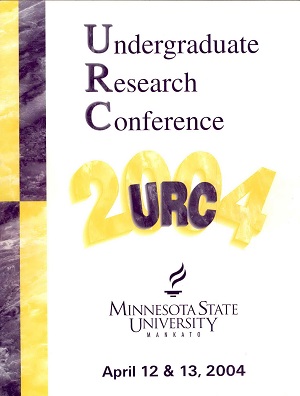Morphological Characterization of Transgenic Murine Myocardium
Location
CSU 253/254/255
Start Date
13-4-2004 12:45 PM
End Date
13-4-2004 2:45 PM
Student's Major
Biological Sciences
Student's College
Science, Engineering and Technology
Mentor's Name
Marilyn Hart
Mentor's Department
Biological Sciences
Mentor's College
Science, Engineering and Technology
Description
In striated muscle, actin capping protein (CP) binds to the barbed end of the actin filament at the Z-line. Capping proteins direct and maintain the proper orientation of the thin filament in the sarcomere. Capping protein is a heterodimer composed of both a and p subunits. In vertebrates, there are three α isoforms (αl, α2, α3) and three β isoforms (β1, β2, β3). In previous studies, transgenic mice were generated that replace the β1 isoform of CP (the specific isoform of the sarcomere) with the ?2 isoform of CP (the non-sarcomeric isoform) using the cardiac-specific promoter of the α-myosin heavy chain (α-MyHC) gene. The α-MyHC promoter turns on at birth, increasing expression as a function of age. The purpose of my research is to characterize the structural abnormalities of transgenic murine myocardium expressing forms in CPs defective in their attachments to the thin filaments of Z lines. Murine hearts, both transgenic and wild-type, ranging in age from 3-12 months were removed and their gross morphology assessed. The hearts were fixed in 10% buffered formaldehyde, dehydrated through a graded series of ethanol washes and embedded in paraffin. Thin sections of the paraffin embedded tissue were prepared using a microtome and collected onto gelatin coated slides. The tissue sections were then stained with hematoxylin and eosin and visualized by transmission brightfield microscopy. Preliminary results confirm that morphological defects increase in both magnitude and frequency as a function of age.
Morphological Characterization of Transgenic Murine Myocardium
CSU 253/254/255
In striated muscle, actin capping protein (CP) binds to the barbed end of the actin filament at the Z-line. Capping proteins direct and maintain the proper orientation of the thin filament in the sarcomere. Capping protein is a heterodimer composed of both a and p subunits. In vertebrates, there are three α isoforms (αl, α2, α3) and three β isoforms (β1, β2, β3). In previous studies, transgenic mice were generated that replace the β1 isoform of CP (the specific isoform of the sarcomere) with the ?2 isoform of CP (the non-sarcomeric isoform) using the cardiac-specific promoter of the α-myosin heavy chain (α-MyHC) gene. The α-MyHC promoter turns on at birth, increasing expression as a function of age. The purpose of my research is to characterize the structural abnormalities of transgenic murine myocardium expressing forms in CPs defective in their attachments to the thin filaments of Z lines. Murine hearts, both transgenic and wild-type, ranging in age from 3-12 months were removed and their gross morphology assessed. The hearts were fixed in 10% buffered formaldehyde, dehydrated through a graded series of ethanol washes and embedded in paraffin. Thin sections of the paraffin embedded tissue were prepared using a microtome and collected onto gelatin coated slides. The tissue sections were then stained with hematoxylin and eosin and visualized by transmission brightfield microscopy. Preliminary results confirm that morphological defects increase in both magnitude and frequency as a function of age.




